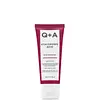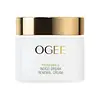What's inside
What's inside
 Key Ingredients
Key Ingredients

 Benefits
Benefits

 Concerns
Concerns

 Ingredients Side-by-side
Ingredients Side-by-side

Water
Skin ConditioningHelianthus Annuus Seed Oil
EmollientCetearyl Alcohol
EmollientGlyceryl Stearate
EmollientGlycerin
HumectantAloe Barbadensis Leaf Juice
Skin ConditioningCaprylic/Capric Triglyceride
MaskingVitis Vinifera Seed Oil
EmollientSodium Hyaluronate
HumectantSodium Hyaluronate Crosspolymer
HumectantPolyglutamic Acid
Skin ConditioningSimmondsia Chinensis Seed Oil
EmollientHydrolyzed Rice Bran Extract
Skin ConditioningSucrose Stearate
EmollientSodium Stearoyl Glutamate
CleansingTocopherol
AntioxidantPropanediol
SolventBenzyl Alcohol
PerfumingSodium Benzoate
MaskingXanthan Gum
EmulsifyingCoco-Glucoside
CleansingCoconut Alcohol
EmollientDehydroacetic Acid
PreservativeLonicera Caprifolium Flower Extract
PerfumingLonicera Japonica Flower Extract
Skin ConditioningCitric Acid
BufferingWater, Helianthus Annuus Seed Oil, Cetearyl Alcohol, Glyceryl Stearate, Glycerin, Aloe Barbadensis Leaf Juice, Caprylic/Capric Triglyceride, Vitis Vinifera Seed Oil, Sodium Hyaluronate, Sodium Hyaluronate Crosspolymer, Polyglutamic Acid, Simmondsia Chinensis Seed Oil, Hydrolyzed Rice Bran Extract, Sucrose Stearate, Sodium Stearoyl Glutamate, Tocopherol, Propanediol, Benzyl Alcohol, Sodium Benzoate, Xanthan Gum, Coco-Glucoside, Coconut Alcohol, Dehydroacetic Acid, Lonicera Caprifolium Flower Extract, Lonicera Japonica Flower Extract, Citric Acid
Aloe Barbadensis Leaf Juice
Skin ConditioningSimmondsia Chinensis Seed Oil
EmollientCetearyl Alcohol
EmollientGlycerin
HumectantLauryl Laurate
Skin ConditioningWater
Skin ConditioningRicinus Communis Seed Oil
MaskingPolyglyceryl-3 Stearate
EmulsifyingAlcohol
AntimicrobialCocos Nucifera Oil
MaskingInulin
Skin ConditioningSclerotium Gum
Emulsion StabilisingVitis Vinifera Seed Oil
EmollientPhenethyl Alcohol
MaskingCopernicia Cerifera Wax
Raspberry Ketone
MaskingCeramide NP
Skin ConditioningSodium Levulinate
Skin ConditioningCitric Acid
BufferingAcmella Oleracea Extract
Skin ProtectingSodium Anisate
AntimicrobialSodium Phytate
Glyceryl Caprylate
EmollientGlyceryl Laurate
EmollientLavandula Angustifolia Oil
MaskingGenipa Americana Fruit Extract
Skin ConditioningTanacetum Annuum Flower Oil
MaskingPhytosphingosine
Skin ConditioningSodium Hyaluronate
HumectantLinalool
PerfumingAloe Barbadensis Leaf Juice, Simmondsia Chinensis Seed Oil, Cetearyl Alcohol, Glycerin, Lauryl Laurate, Water, Ricinus Communis Seed Oil, Polyglyceryl-3 Stearate, Alcohol, Cocos Nucifera Oil, Inulin, Sclerotium Gum, Vitis Vinifera Seed Oil, Phenethyl Alcohol, Copernicia Cerifera Wax, Raspberry Ketone, Ceramide NP, Sodium Levulinate, Citric Acid, Acmella Oleracea Extract, Sodium Anisate, Sodium Phytate, Glyceryl Caprylate, Glyceryl Laurate, Lavandula Angustifolia Oil, Genipa Americana Fruit Extract, Tanacetum Annuum Flower Oil, Phytosphingosine, Sodium Hyaluronate, Linalool
Ingredients Explained
These ingredients are found in both products.
Ingredients higher up in an ingredient list are typically present in a larger amount.
Aloe Barbadensis Leaf Juice comes from leaves of the aloe plant. Aloe Barbadensis Leaf Juice is best known for helping to soothe sunburns. It is also anti-inflammatory, moisturizing, antiseptic, and can help heal wounds.
Aloe is packed with good stuff including Vitamins A, C, and E. These vitamins are antioxidants, which help fight free-radicals and the damage they may cause. Free-radicals are molecules that may damage your skin cells, such as pollution.
Aloe Barbadensis Leaf Juice also contains sugars. These sugars come in the form of monosaccharides and polysaccharides, folic acid, and choline. These sugars are able to help bind moisture to skin.
It also contains minerals such as calcium, 12 anthraquinones, fatty acids, amino acids, and Vitamin B12.
Learn more about Aloe Barbadensis Leaf JuiceCetearyl alcohol is a mixture of two fatty alcohols: cetyl alcohol and stearyl alcohol. It is mainly used as an emulsifier. Emulsifiers help prevent the separation of oils and products. Due to its composition, it can also be used to thicken a product or help create foam.
Cetearyl alcohol is an emollient. Emollients help soothe and hydrate the skin by trapping moisture.
Studies show Cetearyl alcohol is non-toxic and non-irritating. The FDA allows products labeled "alcohol-free" to have fatty alcohols.
This ingredient is usually derived from plant oils such as palm, vegetable, or coconut oils. There is debate on whether this ingredient will cause acne.
Due to the fatty acid base, this ingredient may not be Malassezia folliculitis safe.
Learn more about Cetearyl AlcoholCitric Acid is an alpha hydroxy acid (AHA) naturally found in citrus fruits like oranges, lemons, and limes.
Like other AHAs, citric acid can exfoliate skin by breaking down the bonds that hold dead skin cells together. This helps reveal smoother and brighter skin underneath.
However, this exfoliating effect only happens at high concentrations (20%) which can be hard to find in cosmetic products.
Due to this, citric acid is usually included in small amounts as a pH adjuster. This helps keep products slightly more acidic and compatible with skin's natural pH.
In skincare formulas, citric acid can:
While it can provide some skin benefits, research shows lactic acid and glycolic acid are generally more effective and less irritating exfoliants.
Most citric acid used in skincare today is made by fermenting sugars (usually from molasses). This synthetic version is identical to the natural citrus form but easier to stabilize and use in formulations.
Read more about some other popular AHA's here:
Learn more about Citric AcidGlycerin is already naturally found in your skin. It helps moisturize and protect your skin.
A study from 2016 found glycerin to be more effective as a humectant than AHAs and hyaluronic acid.
As a humectant, it helps the skin stay hydrated by pulling moisture to your skin. The low molecular weight of glycerin allows it to pull moisture into the deeper layers of your skin.
Hydrated skin improves your skin barrier; Your skin barrier helps protect against irritants and bacteria.
Glycerin has also been found to have antimicrobial and antiviral properties. Due to these properties, glycerin is often used in wound and burn treatments.
In cosmetics, glycerin is usually derived from plants such as soybean or palm. However, it can also be sourced from animals, such as tallow or animal fat.
This ingredient is organic, colorless, odorless, and non-toxic.
Glycerin is the name for this ingredient in American English. British English uses Glycerol/Glycerine.
Learn more about GlycerinThis oil comes from the seeds of the desert shrub called Jojoba. It is more commonly known as jojoba oil, a non-comedogenic oil.
Jojoba oil does not contain fragrance and has many fatty-acids, making it a great soothing ingredient.
It also contains Vitamin E, a great moisturizing ingredient. Vitamin E is also an antioxidant and protects your skin against oxidative damage.
This ingredient humectant properties, meaning it helps draw moisture from the air. This helps keep your skin hydrated.
While jojoba has antibacterial properties, it is only able to kill some strains of bacteria.
Studies also show it helps in wound healing. In fact, Indigenous cultures have used jojoba as a moisturizer and to help treat burns for centuries.
Fun fact: Jojoba oil similar to natural human skin sebum, so it has a great effect on dry skin. It is also promising with helping to regulate sebum production.
Due to its fatty acid content, Jojoba oil may not be fungal acne safe. We recommend speaking with a professional if you have any concerns.
Learn more about Simmondsia Chinensis Seed OilSodium Hyaluronate is hyaluronic acid's salt form. It is commonly derived from the sodium salt of hyaluronic acid.
Like hyaluronic acid, it is great at holding water and acts as a humectant. This makes it a great skin hydrating ingredient.
Sodium Hyaluronate is naturally occurring in our bodies and is mostly found in eye fluid and joints.
These are some other common types of Hyaluronic Acid:
Learn more about Sodium HyaluronateVitis Vinifera Seed Oil comes from the grape vine. Grape seeds are a byproduct of creating grape juice or wine.
The components of grape seeds have many skin benefits. Research has found it to be antimicrobial and anti-inflammatory. It also contains many potent antioxidants such as Vitamin E , Vitamin C, proanthocyanidins, polyphenols, flavonoids, and anthocyanins. Proanthocyanidin has been shown to help even out skin tone.
Antioxidants help fight free-radical molecules. Free-radical molecules are capable of damaging our cells and other genetic material. Antioxidants help stabilize free-radicals by donating extra electrons. Grape seed extract may help reduce the signs of aging.
The antimicrobial properties of grape seed may help treat acne. However, more research is needed to support this claim.
Grape seed has also been found to help absorb UV rays. Grape seed extract should not replace your sunscreen.
The fatty acids of grape seed oil give it emollient properties. Emollients help soothe and soften your skin by creating a film. This film traps moisture within, keeping your skin hydrated.
Learn more about Vitis Vinifera Seed OilWater. It's the most common cosmetic ingredient of all. You'll usually see it at the top of ingredient lists, meaning that it makes up the largest part of the product.
So why is it so popular? Water most often acts as a solvent - this means that it helps dissolve other ingredients into the formulation.
You'll also recognize water as that liquid we all need to stay alive. If you see this, drink a glass of water. Stay hydrated!
Learn more about Water